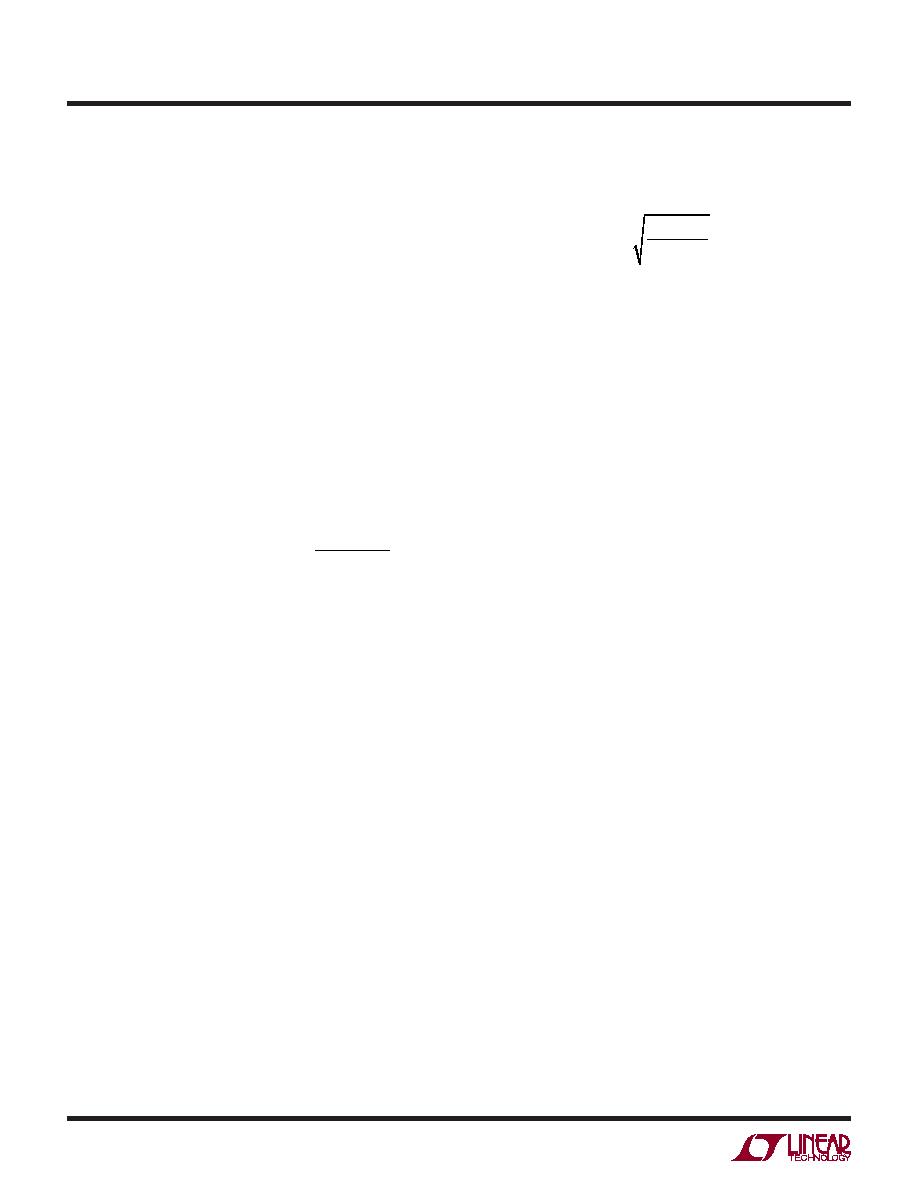- 您現(xiàn)在的位置:買賣IC網(wǎng) > PDF目錄44987 > LT3758HMSE#TRPBF (LINEAR TECHNOLOGY CORP) SWITCHING REGULATOR, 1000 kHz SWITCHING FREQ-MAX, PDSO10 PDF資料下載
參數(shù)資料
| 型號: | LT3758HMSE#TRPBF |
| 廠商: | LINEAR TECHNOLOGY CORP |
| 元件分類: | 穩(wěn)壓器 |
| 英文描述: | SWITCHING REGULATOR, 1000 kHz SWITCHING FREQ-MAX, PDSO10 |
| 封裝: | 3 X 3 MM, LEAD FREE, PLASTIC, MSOP-10 |
| 文件頁數(shù): | 17/36頁 |
| 文件大小: | 554K |
| 代理商: | LT3758HMSE#TRPBF |
第1頁第2頁第3頁第4頁第5頁第6頁第7頁第8頁第9頁第10頁第11頁第12頁第13頁第14頁第15頁第16頁當前第17頁第18頁第19頁第20頁第21頁第22頁第23頁第24頁第25頁第26頁第27頁第28頁第29頁第30頁第31頁第32頁第33頁第34頁第35頁第36頁

LT3758
24
3758fc
Inverting Converter: Inductor, Sense Resistor, Power
MOSFET, Output Diode and Input Capacitor Selections
The selections of the inductor, sense resistor, power
MOSFET, output diode and input capacitor of an inverting
converteraresimilartothoseoftheSEPICconverter.Please
refer to the corresponding SEPIC converter sections.
Inverting Converter: Output Capacitor Selection
The inverting converter requires much smaller output
capacitors than those of the boost, flyback and SEPIC
converters for similar output ripples. This is due to the fact
that, in the inverting converter, the inductor L2 is in series
with the output, and the ripple current flowing through the
outputcapacitorsarecontinuous.Theoutputripplevoltage
is produced by the ripple current of L2 flowing through
the ESR and bulk capacitance of the output capacitor:
VOUT(P–P) = IL2 ESRCOUT +
1
8 f COUT
After specifying the maximum output ripple, the user can
select the output capacitors according to the preceding
equation.
The ESR can be minimized by using high quality X5R or
X7R dielectric ceramic capacitors. In many applications,
ceramic capacitors are sufficient to limit the output volt-
age ripple.
The RMS ripple current rating of the output capacitor
needs to be greater than:
IRMS(COUT) > 0.3 IL2
Inverting Converter: Selecting the DC Coupling Capacitor
The DC voltage rating of the DC coupling capacitor (CDC,
as shown in Figure 10) should be larger than the maximum
input voltage minus the output voltage (negative voltage):
VCDC > VIN(MAX) – VOUT
CDC has nearly a rectangular current waveform. During
the switch off-time, the current through CDC is IIN, while
approximately –IO flows during the on-time. The RMS
rating of the coupling capacitor is determined by the fol-
lowing equation:
IRMS(CDC) >IO(MAX)
DMAX
1
DMAX
A low ESR and ESL, X5R or X7R ceramic capacitor works
well for CDC.
Board Layout
The high speed operation of the LT3758 demands careful
attention to board layout and component placement. The
Exposed Pad of the package is the only GND terminal of
the IC, and is important for thermal management of the
IC. Therefore, it is crucial to achieve a good electrical and
thermal contact between the Exposed Pad and the ground
plane of the board. For the LT3758 to deliver its full output
power, it is imperative that a good thermal path be pro-
vided to dissipate the heat generated within the package.
It is recommended that multiple vias in the printed circuit
board be used to conduct heat away from the IC and into
a copper plane with as much area as possible.
To prevent radiation and high frequency resonance prob-
lems, proper layout of the components connected to the
IC is essential, especially the power paths with higher di/
dt. The following high di/dt loops of different topologies
should be kept as tight as possible to reduce inductive
ringing:
In boost configuration, the high di/dt loop contains
the output capacitor, the sensing resistor, the power
MOSFET and the Schottky diode.
In flyback configuration, the high di/dt primary loop
contains the input capacitor, the primary winding, the
power MOSFET and the sensing resistor. The high di/
dt secondary loop contains the output capacitor, the
secondary winding and the output diode.
In SEPIC configuration, the high di/dt loop contains
the power MOSFET, sense resistor, output capacitor,
Schottky diode and the coupling capacitor.
In inverting configuration, the high di/dt loop contains
power MOSFET, sense resistor, Schottky diode and the
coupling capacitor.
ApplicAtions inForMAtion
相關PDF資料 |
PDF描述 |
|---|---|
| LT3758MPMSE#PBF | SWITCHING REGULATOR, 1000 kHz SWITCHING FREQ-MAX, PDSO10 |
| LT3758HMSE#PBF | SWITCHING REGULATOR, 1000 kHz SWITCHING FREQ-MAX, PDSO10 |
| LT3758MPMSE#TRPBF | SWITCHING REGULATOR, 1000 kHz SWITCHING FREQ-MAX, PDSO10 |
| LT3782IFE#TR | 4 A SWITCHING CONTROLLER, 533 kHz SWITCHING FREQ-MAX, PDSO28 |
| LT3782IFE | 4 A SWITCHING CONTROLLER, 533 kHz SWITCHING FREQ-MAX, PDSO28 |
相關代理商/技術參數(shù) |
參數(shù)描述 |
|---|---|
| LT3758IDD#PBF | 功能描述:IC REG CTRLR BST FLYBK INV 10DFN RoHS:是 類別:集成電路 (IC) >> PMIC - 穩(wěn)壓器 - DC DC 切換控制器 系列:- 標準包裝:2,500 系列:- PWM 型:電流模式 輸出數(shù):1 頻率 - 最大:500kHz 占空比:96% 電源電壓:4 V ~ 36 V 降壓:無 升壓:是 回掃:無 反相:無 倍增器:無 除法器:無 Cuk:無 隔離:無 工作溫度:-40°C ~ 125°C 封裝/外殼:24-WQFN 裸露焊盤 包裝:帶卷 (TR) |
| LT3758IDD#TRPBF | 功能描述:IC REG CTRLR BST FLYBK INV 10DFN RoHS:是 類別:集成電路 (IC) >> PMIC - 穩(wěn)壓器 - DC DC 切換控制器 系列:- 標準包裝:2,500 系列:- PWM 型:電流模式 輸出數(shù):1 頻率 - 最大:500kHz 占空比:96% 電源電壓:4 V ~ 36 V 降壓:無 升壓:是 回掃:無 反相:無 倍增器:無 除法器:無 Cuk:無 隔離:無 工作溫度:-40°C ~ 125°C 封裝/外殼:24-WQFN 裸露焊盤 包裝:帶卷 (TR) |
| LT3758IDDPBF | 制造商:LINER 制造商全稱:Linear Technology 功能描述:High Input Voltage, Boost, Flyback, SEPIC and Inverting Controller |
| LT3758IDDTRPBF | 制造商:LINER 制造商全稱:Linear Technology 功能描述:High Input Voltage, Boost, Flyback, SEPIC and Inverting Controller |
| LT3758IMSE#PBF | 功能描述:IC REG CTRLR PWM CM 10-MSOP RoHS:是 類別:集成電路 (IC) >> PMIC - 穩(wěn)壓器 - DC DC 切換控制器 系列:- 標準包裝:2,500 系列:- PWM 型:電流模式 輸出數(shù):1 頻率 - 最大:500kHz 占空比:96% 電源電壓:4 V ~ 36 V 降壓:無 升壓:是 回掃:無 反相:無 倍增器:無 除法器:無 Cuk:無 隔離:無 工作溫度:-40°C ~ 125°C 封裝/外殼:24-WQFN 裸露焊盤 包裝:帶卷 (TR) |
發(fā)布緊急采購,3分鐘左右您將得到回復。